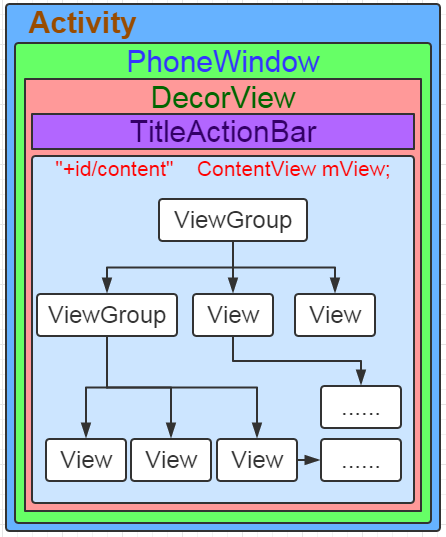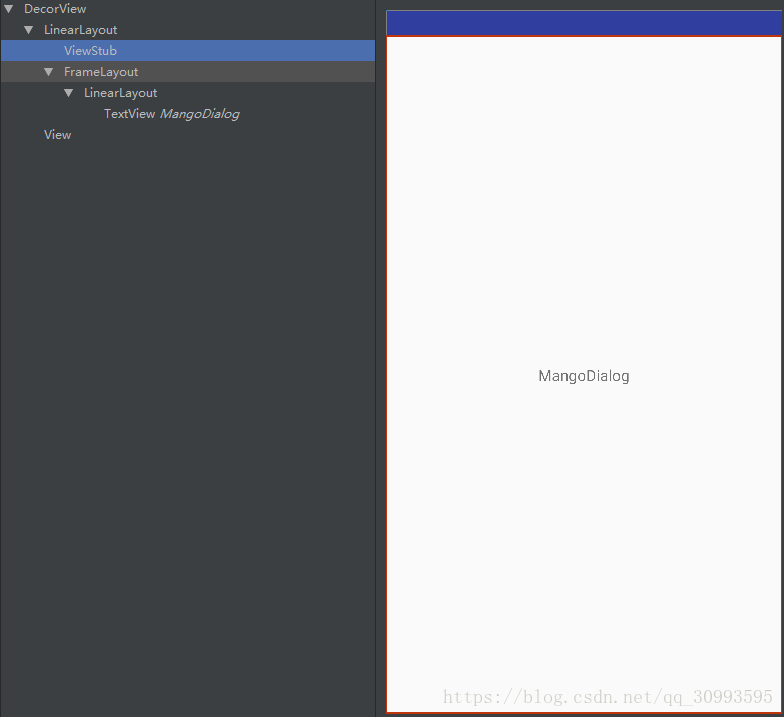不管你是一个刚接触Android开发的新手,还是一个深耕多年的老司机,打开AS新建一个项目开发APP,第一件事就是打开MainActivity,在onCreate方法里调用setContentView,将xml布局索引值传进去。
很多人其实都没注意到这个方法是怎么一个逻辑,就是按照我们当时学习android开发的视频中老师说的,把布局文件放进去,我们的activity就有页面了;其实我在很长一段时间也是这个逻辑,没有想太多,就直接用就行了,直到有一天一个面试题到了我面前,这个方法是怎么执行的?说实话当时有点乱,平时还真没注意过这个方法,一时不知道说什么好,尴尬!!!
今天就来了解下它的神秘之处。
我们使用AndroidStudio新建一个项目,无须添加任何代码,就打开MainActivity,首先我们想到既然setContentView是给Activity设置contentview的,那你对这个activity的整个页面的View结构有什么概念呢?
我们点击AndroidStudio的顶部菜单栏的Tools菜单,依次点击里面的Android》Layout Inspector;这样就会弹出一个展示Activity窗口视图结构的窗口出来,如图
当前activity的布局里只添加了一个textview,并且当前Activity在setContentView之前没有进行Features设置。
当用鼠标放在左边具体view上面,右边视图上会展示相应的范围
- 从这里可以看出来Activity最根部的view是DecorView,后面我们会说到DecorView其实是一个FrameLayout
- DecorView包含两部分,一个装载内容的LinearLayout和一个顶部View
- LinearLayout包含一个ViewStub和FrameLayout,其实就是一个action_bar,只不过使用ViewStub来修饰,因为开发者是可以设置不要标题栏的;至于FrameLayout就是真正装载我们通过setContentView设置进去的View
- 最后这个TextView就是我们自己布局的内容
结构了解之后再回来通过setContentView去探索它是怎么形成的:
Activity setContentView
通过在onCreate中点击setContentView方法进入到源码中查看
public void setContentView(@LayoutRes int layoutResID) {
getWindow().setContentView(layoutResID);
initWindowDecorActionBar();
}这里先调用getWindow()方法
public Window getWindow() {
return mWindow;
}这个mWindow是activity类的全局变量 private Window mWindow;它是在attach方法中实例化的,并且实现了Callback接口,这个后续会用到
mWindow = new PhoneWindow(this, window);
mWindow.setCallback(this);可以看到其实是实例化了一个PhoneWindow对象,Window是个什么东西呢,可以这样说,它是顶级窗口外观和行为策略的抽象基类。 应该将此类的实例用作添加到窗口管理器的顶级视图。 它提供标准的UI策略,例如背景,标题区域,默认密钥处理等。此抽象类的唯一现有实现是android.view.PhoneWindow。
PhoneWindow setContentView
回到setContentView方法,获取窗口实例后,调用PhoneWindow的setContentView方法:
@Override
public void setContentView(int layoutResID) {
// Note: FEATURE_CONTENT_TRANSITIONS may be set in the process of installing the window
// decor, when theme attributes and the like are crystalized. Do not check the feature
// before this happens.
if (mContentParent == null) {
installDecor();
} else if (!hasFeature(FEATURE_CONTENT_TRANSITIONS)) {
mContentParent.removeAllViews();
}
if (hasFeature(FEATURE_CONTENT_TRANSITIONS)) {
final Scene newScene = Scene.getSceneForLayout(mContentParent, layoutResID,
getContext());
transitionTo(newScene);
} else {
mLayoutInflater.inflate(layoutResID, mContentParent);
}
mContentParent.requestApplyInsets();
final Callback cb = getCallback();
if (cb != null && !isDestroyed()) {
cb.onContentChanged();
}
mContentParentExplicitlySet = true;
}我们第一次进来的时候,这个mContentParent(这个就是装载我们设置的布局view的容器)肯定是null,那么就进入installDecor方法,这个方法很长,就不全部贴上来了,贴关键部分
if (mDecor == null) {
//通过new 创建Decorview
mDecor = generateDecor(-1);
mDecor.setDescendantFocusability(ViewGroup.FOCUS_AFTER_DESCENDANTS);
mDecor.setIsRootNamespace(true);
if (!mInvalidatePanelMenuPosted && mInvalidatePanelMenuFeatures != 0) {
mDecor.postOnAnimation(mInvalidatePanelMenuRunnable);
}
} else {
mDecor.setWindow(this);
}
if (mContentParent == null) {
//根据mDecor实例获取mContentParent
mContentParent = generateLayout(mDecor);第一步:如果DecorView为null,就通过generateDecor来构造一个实例,看看DecorView这个类
public class DecorView extends FrameLayout
说明这就是布局控件,也表明Activity的根布局就是一个FrameLayout
第二步:根布局有了,就需要往里面塞东西了,这时候就判断如果mContentParent 为null,就通过generateLayout来构建,我们看看这个方法,这个方法很长,我把一些类似的代码删了
protected ViewGroup generateLayout(DecorView decor) {
// Apply data from current theme.
//根据Manifest里设置的theme来进行相应设置
TypedArray a = getWindowStyle();
if (false) {
System.out.println("From style:");
String s = "Attrs:";
for (int i = 0; i < R.styleable.Window.length; i++) {
s = s + " " + Integer.toHexString(R.styleable.Window[i]) + "="
+ a.getString(i);
}
System.out.println(s);
}
mIsFloating = a.getBoolean(R.styleable.Window_windowIsFloating, false);
int flagsToUpdate = (FLAG_LAYOUT_IN_SCREEN|FLAG_LAYOUT_INSET_DECOR)
& (~getForcedWindowFlags());
if (mIsFloating) {
setLayout(WRAP_CONTENT, WRAP_CONTENT);
setFlags(0, flagsToUpdate);
} else {
setFlags(FLAG_LAYOUT_IN_SCREEN|FLAG_LAYOUT_INSET_DECOR, flagsToUpdate);
}
//比如主题里设置了notitle,这里就会进行设置
if (a.getBoolean(R.styleable.Window_windowNoTitle, false)) {
requestFeature(FEATURE_NO_TITLE);
} else if (a.getBoolean(R.styleable.Window_windowActionBar, false)) {
// Don't allow an action bar if there is no title.
requestFeature(FEATURE_ACTION_BAR);
}
.
.
.
.
// Inflate the window decor.
//添加布局到DecorView,前面说到,DecorView是继承与FrameLayout,它本身也是一个ViewGroup,
// 而我们前面创建它的时候,只是调用了new DecorView,此时里面并无什么东西。
// 而下面的步骤则是根据用户设置的Feature来创建相应的默认布局主题。举个例子,
// 如果我在setContentView之前调用了requestWindowFeature(Window.FEATURE_NO_TITLE),
// 这里则会通过getLocalFeatures来获取你设置的feature,进而选择加载对应的布局,
// 此时MainActivity没有进行任何设置,对应的就是R.layout.screen_simple
int layoutResource;
int features = getLocalFeatures();
// System.out.println("Features: 0x" + Integer.toHexString(features));
if ((features & (1 << FEATURE_SWIPE_TO_DISMISS)) != 0) {
layoutResource = R.layout.screen_swipe_dismiss;
} else if ((features & ((1 << FEATURE_LEFT_ICON) | (1 << FEATURE_RIGHT_ICON))) != 0) {
if (mIsFloating) {
TypedValue res = new TypedValue();
getContext().getTheme().resolveAttribute(
R.attr.dialogTitleIconsDecorLayout, res, true);
layoutResource = res.resourceId;
} else {
layoutResource = R.layout.screen_title_icons;
}
// XXX Remove this once action bar supports these features.
removeFeature(FEATURE_ACTION_BAR);
// System.out.println("Title Icons!");
} else if ((features & ((1 << FEATURE_PROGRESS) | (1 << FEATURE_INDETERMINATE_PROGRESS))) != 0
&& (features & (1 << FEATURE_ACTION_BAR)) == 0) {
// Special case for a window with only a progress bar (and title).
// XXX Need to have a no-title version of embedded windows.
layoutResource = R.layout.screen_progress;
// System.out.println("Progress!");
} else if ((features & (1 << FEATURE_CUSTOM_TITLE)) != 0) {
// Special case for a window with a custom title.
// If the window is floating, we need a dialog layout
if (mIsFloating) {
TypedValue res = new TypedValue();
getContext().getTheme().resolveAttribute(
R.attr.dialogCustomTitleDecorLayout, res, true);
layoutResource = res.resourceId;
} else {
layoutResource = R.layout.screen_custom_title;
}
// XXX Remove this once action bar supports these features.
removeFeature(FEATURE_ACTION_BAR);
} else if ((features & (1 << FEATURE_NO_TITLE)) == 0) {
// If no other features and not embedded, only need a title.
// If the window is floating, we need a dialog layout
if (mIsFloating) {
TypedValue res = new TypedValue();
getContext().getTheme().resolveAttribute(
R.attr.dialogTitleDecorLayout, res, true);
layoutResource = res.resourceId;
} else if ((features & (1 << FEATURE_ACTION_BAR)) != 0) {
layoutResource = a.getResourceId(
R.styleable.Window_windowActionBarFullscreenDecorLayout,
R.layout.screen_action_bar);
} else {
layoutResource = R.layout.screen_title;
}
// System.out.println("Title!");
} else if ((features & (1 << FEATURE_ACTION_MODE_OVERLAY)) != 0) {
layoutResource = R.layout.screen_simple_overlay_action_mode;
} else {
// Embedded, so no decoration is needed.
layoutResource = R.layout.screen_simple;
// System.out.println("Simple!");
}
mDecor.startChanging();
//将上述确定的布局添加到mDecor中 mDecor其实是一个FrameLayout
mDecor.onResourcesLoaded(mLayoutInflater, layoutResource);
//contentParent是mDecor布局中的一个子view FrameLayout id是content
ViewGroup contentParent = (ViewGroup)findViewById(ID_ANDROID_CONTENT);
if (contentParent == null) {
throw new RuntimeException("Window couldn't find content container view");
}
if ((features & (1 << FEATURE_INDETERMINATE_PROGRESS)) != 0) {
ProgressBar progress = getCircularProgressBar(false);
if (progress != null) {
progress.setIndeterminate(true);
}
}
if ((features & (1 << FEATURE_SWIPE_TO_DISMISS)) != 0) {
registerSwipeCallbacks();
}
// Remaining setup -- of background and title -- that only applies
// to top-level windows.
if (getContainer() == null) {
final Drawable background;
if (mBackgroundResource != 0) {
background = getContext().getDrawable(mBackgroundResource);
} else {
background = mBackgroundDrawable;
}
mDecor.setWindowBackground(background);
final Drawable frame;
if (mFrameResource != 0) {
frame = getContext().getDrawable(mFrameResource);
} else {
frame = null;
}
mDecor.setWindowFrame(frame);
mDecor.setElevation(mElevation);
mDecor.setClipToOutline(mClipToOutline);
if (mTitle != null) {
setTitle(mTitle);
}
if (mTitleColor == 0) {
mTitleColor = mTextColor;
}
setTitleColor(mTitleColor);
}
mDecor.finishChanging();
return contentParent;
}方法很长,我们从头看,
- 首先调用getWindowStyle()方法,这个就是获取我们在AndroidManifest里对activity设置的Theme,然后做相应的设置;比如主题里设置了windowNoTitle,那这里就会设置不要标题栏
- 接下来会调用getLocalFeatures()方法,我们有时候会在activity的setContentView方法前设置requestWindowFeature(Window.FEATURE_NO_TITLE)类似的属性,这个方法就是获取这些设置的并做相应的处理;这也说明了为什么我们要在setContentView之前调用这些设置方法了
- 我上面的例子没有做相关设置,if-else语句最终会走到最后一个layoutResource = R.layout.screen_simple;这个布局文件就会通过下面的 mDecor.onResourcesLoaded(mLayoutInflater, layoutResource)方法被添加到DecorView中,看看这个布局代码
<LinearLayout xmlns:android="http://schemas.android.com/apk/res/android"
android:layout_width="match_parent"
android:layout_height="match_parent"
android:fitsSystemWindows="true"
android:orientation="vertical">
<ViewStub android:id="@+id/action_mode_bar_stub"
android:inflatedId="@+id/action_mode_bar"
android:layout="@layout/action_mode_bar"
android:layout_width="match_parent"
android:layout_height="wrap_content"
android:theme="?attr/actionBarTheme" />
<FrameLayout
android:id="@android:id/content"
android:layout_width="match_parent"
android:layout_height="match_parent"
android:foregroundInsidePadding="false"
android:foregroundGravity="fill_horizontal|top"
android:foreground="?android:attr/windowContentOverlay" />
</LinearLayout>这个布局是不是跟我最上面贴的activity的视图结构一样的,这样之前构建的DecorView这个ViewGroup里就有内容了
4. 添加完之后就要获取这个布局里面的view拿来用了,然后就有这句
ViewGroup contentParent = (ViewGroup)findViewById(ID_ANDROID_CONTENT);
public static final int ID_ANDROID_CONTENT = com.android.internal.R.id.content;这样就拿到了布局里的FrameLayout并赋值给contentParent,最后把这个contentParent返回
第三步:mContentParent 这样就有值了,installDecor就基本上结束了
最后再回到setContentView方法
通过installDecor方法构建了一个DecorView,这个是作为Activity的根部View,并且添加了一个布局到DecorView里;通过id找到布局里的FrameLayout赋值给mContentParent ,这个ViewGroup就是用来给我们放置要设置的布局的
接下来会执行到mLayoutInflater.inflate(layoutResID, mContentParent);第一个参数就是我们传入的布局id,第二个参数就是上面构建的FrameLayout。
这个inflate方法最终会走到下面
public View inflate(@LayoutRes int resource, @Nullable ViewGroup root, boolean attachToRoot) {
final Resources res = getContext().getResources();
if (DEBUG) {
Log.d(TAG, "INFLATING from resource: \"" + res.getResourceName(resource) + "\" ("
+ Integer.toHexString(resource) + ")");
}
final XmlResourceParser parser = res.getLayout(resource);
try {
return inflate(parser, root, attachToRoot);
} finally {
parser.close();
}
}
public View inflate(XmlPullParser parser, @Nullable ViewGroup root, boolean attachToRoot) {
synchronized (mConstructorArgs) {
//记录解析日志
Trace.traceBegin(Trace.TRACE_TAG_VIEW, "inflate");
final Context inflaterContext = mContext;
//通过parser得到layout中的所有view的属性集保存在attrs中
final AttributeSet attrs = Xml.asAttributeSet(parser);
Context lastContext = (Context) mConstructorArgs[0];
mConstructorArgs[0] = inflaterContext;
View result = root;
try {
// Look for the root node.
int type;
while ((type = parser.next()) != XmlPullParser.START_TAG &&
type != XmlPullParser.END_DOCUMENT) {
// Empty
}
if (type != XmlPullParser.START_TAG) {
throw new InflateException(parser.getPositionDescription()
+ ": No start tag found!");
}
//得到layout的节点,例如,view、merge、include等
final String name = parser.getName();
if (DEBUG) {
System.out.println("**************************");
System.out.println("Creating root view: "
+ name);
System.out.println("**************************");
}
if (TAG_MERGE.equals(name)) {
if (root == null || !attachToRoot) {
throw new InflateException("<merge /> can be used only with a valid "
+ "ViewGroup root and attachToRoot=true");
}
rInflate(parser, root, inflaterContext, attrs, false);
} else {
// Temp is the root view that was found in the xml
final View temp = createViewFromTag(root, name, inflaterContext, attrs);
ViewGroup.LayoutParams params = null;
if (root != null) {
if (DEBUG) {
System.out.println("Creating params from root: " +
root);
}
// Create layout params that match root, if supplied
params = root.generateLayoutParams(attrs);
if (!attachToRoot) {
// Set the layout params for temp if we are not
// attaching. (If we are, we use addView, below)
temp.setLayoutParams(params);
}
}
if (DEBUG) {
System.out.println("-----> start inflating children");
}
// Inflate all children under temp against its context.
rInflateChildren(parser, temp, attrs, true);
if (DEBUG) {
System.out.println("-----> done inflating children");
}
// We are supposed to attach all the views we found (int temp)
// to root. Do that now.
if (root != null && attachToRoot) {
root.addView(temp, params);
}
// Decide whether to return the root that was passed in or the
// top view found in xml.
if (root == null || !attachToRoot) {
result = temp;
}
}
} catch (XmlPullParserException e) {
final InflateException ie = new InflateException(e.getMessage(), e);
ie.setStackTrace(EMPTY_STACK_TRACE);
throw ie;
} catch (Exception e) {
final InflateException ie = new InflateException(parser.getPositionDescription()
+ ": " + e.getMessage(), e);
ie.setStackTrace(EMPTY_STACK_TRACE);
throw ie;
} finally {
// Don't retain static reference on context.
mConstructorArgs[0] = lastContext;
mConstructorArgs[1] = null;
Trace.traceEnd(Trace.TRACE_TAG_VIEW);
}
return result;
}
}这方法逻辑就是通过createViewFromTag方法不断解析并创建出对应的view,然后通过root.addView(temp, params)方法,就将我们编写的布局添加到了mContentParent 这个FrameLayout布局中。
最后就是通过cb.onContentChanged()来通知activity布局内容已经变化了;在最上面我们知道Activity的attach方法中实例化PhoneWindow的时候注册了这个接口,并实现了onContentChanged方法
public void onContentChanged() {
}显然这是一个空的实现,所以我们可以在我们自己的Activity里重写这个方法来监测页面布局的变化。
到这里setContentView方法就分析结束了,做个总结
- Activity启动后在attach方法中会实例化一个PhoneWindow对象,说明每个Activity都会拥有一个Window窗口,并且界面展示的特性是由Window控制
- 我们的Activity通过setContentView方法设置页面内容,会走到PhoneWindow类的setContentView方法中
- 在setContentView方法中,会实例化一个DecorView,这是每个Activity根布局,并根据Theme,Feature往这个布局里添加了一个LinearLayout
4.LinearLayout布局里有title和FrameLayout,把FrameLayout作为mContentParent来存放我们添加的ViewGroup或者View - 最后通过Callback来通知activity页面布局更新
最终就是这张图,网上借鉴

